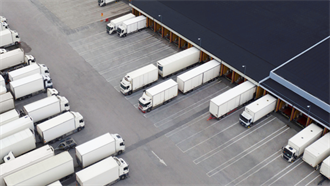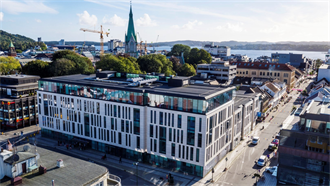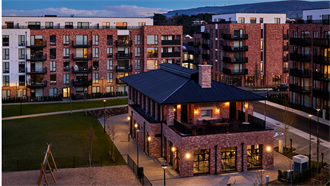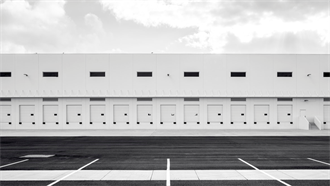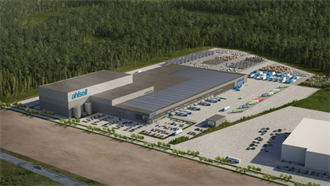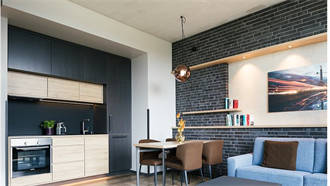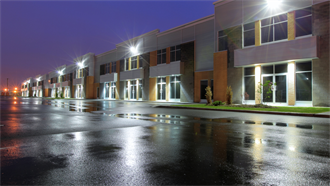Stephan Riechers, head of investment management logistics & light industrial at Union Investment, explains why investing in the French market now makes sense despite falling yields.
France was relatively hard hit by the coronavirus pandemic, with freight traffic and the logistics sector – like the wider economy – significantly impacted by border closures, declining demand and production shutdowns. At the same time, the systemic importance of the sector was highlighted, as in other European countries.
Despite the various restrictions, logistics chains have continued to function and ensure that daily necessities remained available. The logistics businesses that were affected have largely depended on the industries they serve. The food sector, for example, has escaped largely unscathed, while export-oriented industries such as automotive have been more severely affected.
But for one segment in particular, Covid-19 restrictions created a powerful tailwind, namely e-commerce. According to a study by market research institute Kantar, the share of consumers that execute 50% or more of their total purchases online increased by between 25 - 80% in Europe’s biggest e-commerce markets – the UK, Germany and France – during the pandemic.
Strong investment demand
The decline of brick-and-mortar retail in the non-food sector has triggered a boom in the logistics markets, which has attracted an increasing number of real estate investors in recent years. The pandemic has further accelerated this underlying trend.
France is one of the three largest logistics property markets in Europe. Despite the coronavirus pandemic, the French transaction market posted its second-best year ever in 2020, with logistics properties worth a total of around €3.4 bn changing hands. In 2019, the strongest year to date, transactions exceeded €4.6 bn.
Notably, portfolio deals accounted for 70% of investment last year. Demand in the French logistics investment market is likely to remain buoyant this year as well, supported by good liquidity. Prices for French logistics properties are holding up, with no sign of coronavirus discounts. In fact, the situation is gradually easing and the seven-day incidence rate in France has dropped below 100.
Prime yields for logistics real estate in France declined from 3.9 to 3.5% in the first quarter of this year. Given strong demand and increasingly constrained supply, the likelihood is that yields will fall further in the medium term.
Union Investment has been active in the French market for around 20 years, primarily as an office investor. The Hamburg-based real estate investment manager has also had its own asset management unit in Paris since 2005.The company entered the French logistics market in 2019 when it acquired Logistrial Real Estate AG from GARBE Industrial Real Estate.
The associated portfolio of 19 logistics properties included a development project in Ensisheim (pictured above) in north-eastern France. Located close to the German border, the facility comprises two warehouses offering a total of some 100,000 m² of logistics space on a 185,000 m² site. A second acquisition in the French logistics market is set to follow this year via a sale-and-leaseback transaction. Union Investment is aiming to double the size of its logistics portfolio in the medium term. A total of twelve European countries are on the acquisition radar, including the Netherlands, Germany, Scandinavia and Poland alongside France.
Despite the prospect of lower yields, it is not too late to increase exposure to the French market: in-demand logistics regions will continue to suffer from a lack of space. In the first quarter of 2021, there was 2,800,000 m² of empty space in the French logistics market, corresponding to a vacancy rate of approximately 5.8%.
This figure masks considerable variation between individual markets. Lille, for example, has a vacancy rate of around 9.5% and remains oversupplied, while the market is tight in the Rhône-Alpes and Provence-Alpes-Côte d’Azur (PACA) regions, with vacancies running at around 1.3 - 1.9%. The Greater Paris area ranks mid-table, recording more than 900,000 sq m of empty space in the first quarter of 2021, equating to a vacancy rate of approximately 6.6%.
Against this backdrop, sites are likely to increase in value in many regions, while the constrained market will put upward pressure on rents. Last year saw rent rises in some places despite coronavirus, and rental expectations remain positive in most locations.
An additional factor is that acquisition yields on logistics real estate in many French regions, especially Greater Paris, are still higher than comparable office yields.
Creation of largest logistics hub in Europe
The French logistics rental market is in buoyant shape, as evidenced by the findings of a recent survey by real estate advisor CBRE and Analytiqa that covered more than 100 of the biggest European logistics occupiers. 25% of the respondents said that they expect to expand their presence in the country. This puts France in pole position, ahead of Germany (20%) and Spain (19%).
All the big international companies have a base in France, with the country benefiting from its central location within Europe and two major ports, Le Havre and Marseille, plus having access to the UK via the Channel Tunnel. However, after record take-up in the fourth quarter of 2020, the French rental market got off to a slow start in 2021.
In the first quarter of this year, take-up of logistics space was a little over 600,000 m², a decrease of 12% on the prior-year period and around 18% less than the ten-year average. Letting activity has declined even further in some central axis markets.
In the Hautsde- France region, for example, 34% less space was turned over in the first quarter of 2021 than in the prior-year quarter, totalling some 91,000 m², while lettings plummeted by 74% in Auvergne-Rhône-Alpes (15,000 m²) and take-up was down 75% in the PACA region at just under 32,000 m². By contrast, the Greater Paris market saw take-up of over 115,000 m², representing an impressive 76% increase, albeit flattered by a somewhat weak first quarter in 2020.
New builds and build-to-suit facilities remain the most popular options. In the first quarter of this year, new builds accounted for 66% of take-up, with build-to-suit logistics facilities making up 40%. These statistics reflect a growing corporate focus on efficiency and sustainability. Investors and tenants alike are attaching ever greater importance to BREEAM or DGNB sustainability certification.
Overall, the market has been well supported by strong demand for e-commerce and urban logistics. That trend is likely to grow over the coming years. In northern France, what is probably Europe’s largest logistics hub is currently under construction on the site of the former Cambrai-Epinoy air base. Called “e-Valley”, the clue is in the name: this development is all about e-commerce. The BT Immo Group is building eight warehouses comprising over 700,000 m² of space on a 320 ha site. The first two structures, offering 117,000 m² of rental space, have already been completed and are fully let.
Logistics services providers are particularly responsive
Demand for logistics space – both in France and beyond – could rise significantly in the medium term. Many just-in-time concepts, where production materials are not delivered until the moment they are needed, have been reassessed in the wake of the pandemic.
This strategic shift will lead to a marked increase in domestic production capacity and higher demand for storage space. The first signs are already apparent in France. Logistics providers still account for a significant share of the French rental market and are proving particularly responsive to supply chain restructuring. Online sales and lastmile delivery are additional factors that will drive demand for logistics space.
The key takeaway is that in France, and also elsewhere, rents for logistics real estate are characterised by relatively low volatility when viewed over an extended period, combined with longer-than-average lease terms. This asset class can thus add stability to a mixed-use portfolio.

























